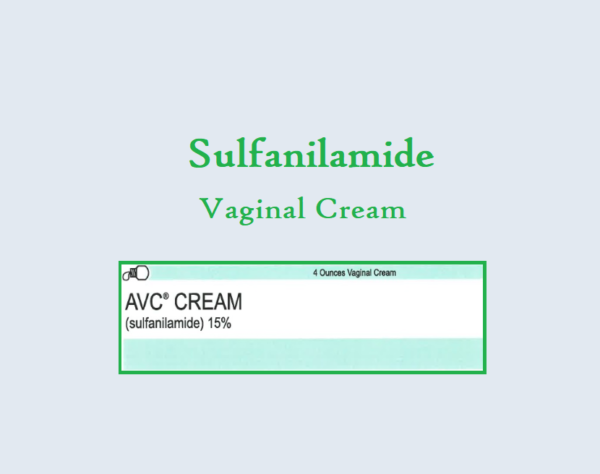A bacteriostatic antibiotic called sulfanilamide vaginal cream is used to treat vaginal infections brought on by candida albicans. Due to its low effectiveness and strong adverse responses, it is rarely used today.
Sulfanilamide Vaginal Cream Uses:
-
Vulvovaginitis:
- It is indicated for the treatment of vulvovaginitis caused by Candida albicans.
Sulfanilamide Vaginal Cream Dose in Adults
Sulfanilamide Vaginal Cream Dose in the treatment of Vulvovaginitis:
- Intravaginal Use:
- Insert one applicatorful intravaginally once or two times a day for 30 days.
Use in Children:
Not indicated.
Pregnancy Risk Category: C
- Negative pregnancy outcomes have been linked to the use of sulfanilamide and other sulfonamides. It crosses the placental barrier to enter the amniotic liquid.
- Concentrations in the fetal blood can reach as high as 50% to 90% of those found in the maternal blood.
- Because of the potential for kernicterus in the infant, it should not be used during the last weeks of pregnancy. Before delivery, the neonatologists should know about the use of the drug by the mother.
- After the seventh month, vaginal topical medication (applicators or inserts) should also be avoided
Use during breastfeeding:
- Breastmilk can contain the drug if it is used by the mother. It can cause kernicterus to the baby who is breastfeeding.
- Manufacturer recommends that you stop breastfeeding while taking the medication (or stopping breastfeeding after weighing the benefits and risks).
Dose in Kidney Disease:
There are no dosage adjustments provided in the manufacturer’s labeling
Dose in Liver disease:
There are no dosage adjustments provided in the manufacturer’s labeling
Side effects of Sulfanilamide:
- Oral formulations have been discontinued because of very serious side effects.
- Topical application may be associated with local adverse drug reactions like rash, redness, itching, and swelling.
- It may cause itching and hypersensitivity reactions of the penis (during sexual intercourse)
Contraindications to Sulfanilamide:
- Hypersensitivity to sulfanilamide or any sulfonamide or any component in the formulation
Warnings and precautions
-
Blood dyscrasias:
- There have been fatalities associated with the use of sulfonamides.
- Side effects that can cause adverse blood reactions include anemia, agranulocytosis and other blood dyscrasias, such as thrombocytopenia.
-
Dermatologic reactions
- Secondary to the use sulfonamides, including toxic epidermal necrosis and stevens Johnson syndrome, severe skin reactions can occur.
-
Hepatic necrosis
- Sulfonamides have been linked to severe, sometimes fatal, hepatic necrosis. This can lead to liver failure.
-
Hypersensitivity reactions
- No matter the route taken to sulfonamide, severe drug hypersensitivity reactions have been reported.
-
Allergy to sulfonamide
- Sulfonamide drugs are chemically similar to many other commonly used drugs including sulfonylureas, arbonic anhydrase inhibitors, thiazides, and loop diuretics except ethacrynic acid.
- Avoid sulfa medications for patients who are allergic to them.
- Cross-sensitivity reactions can also occur due to allergic reactions to drugs that contain the sulfuryl group.
- Patients allergic to sulfa drugs should avoid these drugs if they have had a severe reaction.
Sulfanilamide: Drug Interaction
|
Ajmaline |
Sulfonamides might make ajmaline more harmful or poisonous. In particular, there may be an elevated risk for cholestasis. |
|
Dexketoprofen |
Sulfonamides' harmful or poisonous effects could be amplified. |
|
Mecamylamine |
Sulfonamides may intensify Mecamylamine's harmful or hazardous effects. |
|
Progesterone |
Vaginal antifungal agents may reduce progesterone's therapeutic efficacy. |
Monitoring Parameters:
None mentioned. Monitor the response to treatment.
How to administer Sulfanilamide?
Intravaginal:
- It is used topically with the applicator provided by the manufacturer.
- The applicator should be inserted deep into the vagina without causing any discomfort.
- The applicator should be washed thoroughly after each use and dried before putting it back together.
Mechanism of action of Sulfanilamide:
- It is a bacteriostatic drug that interferes with growth and microbial folic acids synthesis.
- Its inhibitory effect on para-aminiobenzoic acids metabolism is the main mechanism of action.
International Brands of Sulfanilamide:
- AVC Vaginal
Sulfanilamide Brand Names in Pakistan:
Sulfanilamide Cream 15 %w/w in Pakistan |
|
| Sulphakream-N | Nabiqasim Industries (Pvt) Ltd. |







